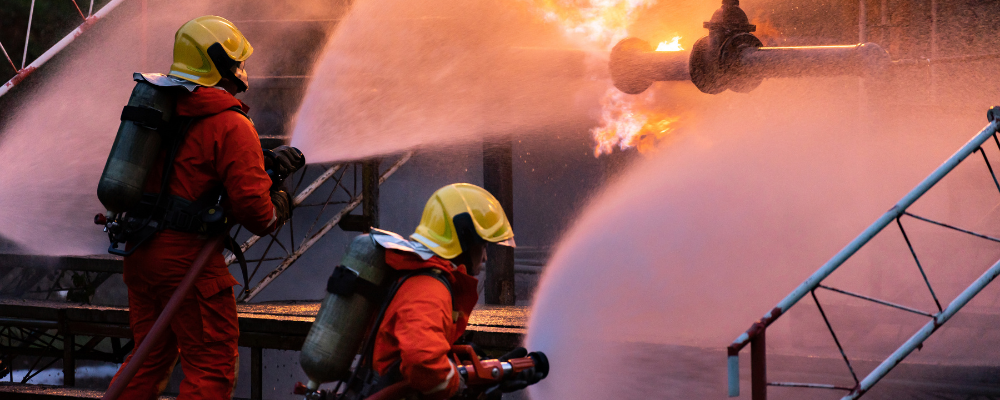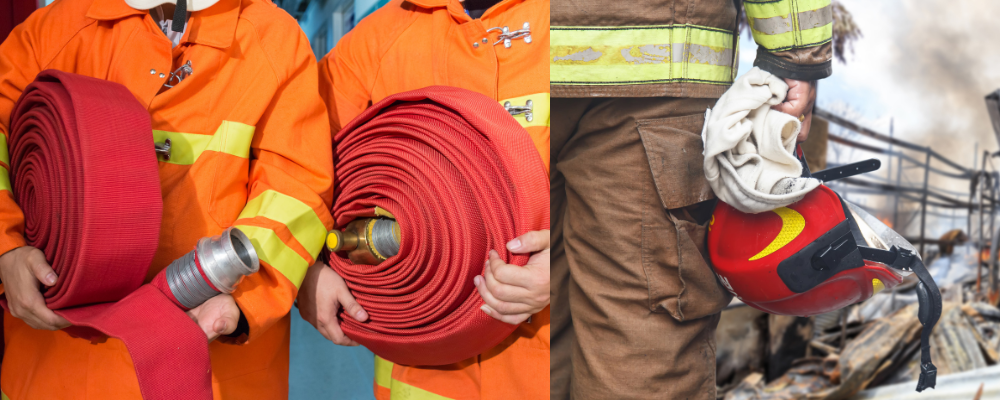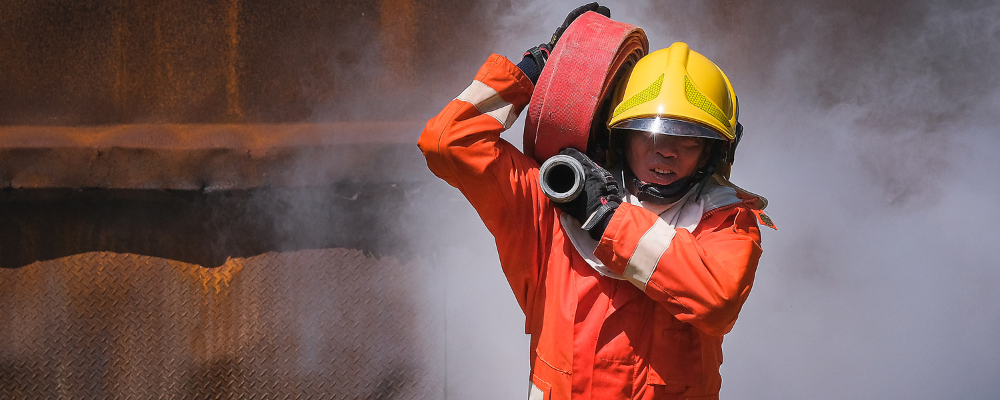
Introduction:
Construction sites present unique fire hazards due to flammable materials, equipment, and various activities that can trigger fires.. Construction sites are dynamic environments that require vigilant attention to safety, and among the numerous safety concerns, fire safety is paramount. This blog explores the critical aspects of fire safety explicitly tailored for construction workers.
Fire Extinguishers: Badger™ and Kidde Pro Line
Badger™ Extra High-Flow Fire Extinguisher
Designed for high-risk environments, the Badger™ Extra High-Flow 10 lb ABC Fire Extinguisher is a robust tool ensuring swift and effective fire suppression. Its key features include:
- High-Flow Design: Enables rapid discharge, crucial for combating fires in construction settings where time is of the essence.
- Multi-Class Capabilities: Versatile for fighting Class A, B, and C fires, encompassing materials and flammable liquids often in construction zones.
- Wall Hook for Accessibility: Ease of access and visibility, ensuring quick response during emergencies.
Kidde Pro Line Fire Extinguisher
The Kidde Pro Line 10 lb ABC Fire Extinguisher offers a comprehensive solution tailored for construction sites. Noteworthy attributes include:
- Robust Build: Constructed for durability and reliability, focusing on enduring the rigors of construction environments.
- Wall Hook for Accessibility: Positioned for immediate access during emergencies, ensuring readiness at all times.
- Capacity and Efficiency: The ability to handle diverse fires efficiently offers peace of mind on-site.
A Closer Look at Essential Fire Safety Products
Construction fire safety involves a multifaceted approach to preventing, detecting, and effectively managing fires. It encompasses a wide array of tools, equipment, and practices that are indispensable for maintaining the safety and integrity of construction sites.
-
Badger™ Extra High-Flow 10 lb ABC Fire Extinguisher w/ Wall Hook
The Badger™ Extra High-Flow 10 lb ABC Fire Extinguisher with Wall Hook is a formidable asset in your fire safety toolkit. Its exceptional high-flow capacity enables it to combat various fire types, including fires involving ordinary combustibles, flammable liquids, and electrical equipment.
-
FireTech™ Canned Smoke
FireTech™ Canned Smoke plays a pivotal role in fire safety testing and training. This product generates non-toxic smoke to simulate natural fire conditions, enabling construction workers to hone their emergency response skills.
-
Smoke Detector Tester
The functionality of smoke detectors cannot be underestimated. The Smoke Detector Tester offers a quick and reliable means of ensuring the correct operation of smoke alarms at construction sites, enhancing early fire detection.
-
Kidde 2.75 lb BC Automotive Extinguisher FC10
The Kidde 2.75 lb BC Automotive Extinguisher FC10, designed specifically for automotive applications, provides a compact and efficient solution for construction workers dealing with vehicles and equipment on-site. Its readiness is vital in the event of fire-related emergencies.
Essential Fire Safety Equipment for Construction Workers
Fire safety equipment is pivotal on construction sites, and selecting the right tools can significantly impact workers’ safety. Here, we delve into the critical equipment tailored for these environments.
Fire Extinguisher Accessories: Vehicle Brackets and Automotive Extinguisher
Badger™ Vehicle Bracket
Enhancing the accessibility and portability of fire extinguishers, the Badger™ Vehicle Bracket is a crucial accessory for construction vehicles. Its significance lies in:
- Secure Mounting: Ensures stability and accessibility of the extinguisher within vehicles, facilitating quick response to fire incidents during transit or on-site.
- Compatibility: Designed to accommodate 2.5 & 2.75 lb extinguishers, providing flexibility in equipping cars with the necessary safety tools.
Kidde 2.75 lb BC Automotive Extinguisher FC10
Tailored specifically for automotive environments within construction, the Kidde 2.75 lb BC Automotive Extinguisher FC10 boasts essential features such as:
- Compact Design: Ideal for smaller fires commonly encountered in vehicles, ensuring efficient extinguishing without causing collateral damage.
- Focused Application: Specific to Class B and C fires, addressing the types often prevalent in automotive settings.
FireTech™ Scored Break Front Cabinet Cover
The FireTech™ Scored Break Front Cabinet Cover serves a crucial protective role on construction sites. Its purpose and benefits include:
- Protective Shield: Shields fire extinguisher cabinets from external elements, preventing accidental damage or tampering.
- Clarity and Ease of Access: Clear design ensures visibility and quick access to the extinguisher, complementing emergency response protocols.
- Simplified Installation: Designed for effortless installation, ensuring minimal downtime during setup.
In conclusion, these fire safety tools and accessories – from high-flow extinguishers to specialized brackets and protective covers – form a comprehensive suite of equipment tailored to safeguard construction workers and sites from potential fire hazards.
Fire Safety Procedures and Training
In fire safety procedures and training for construction workers, evacuation protocols, handling emergencies, and proper usage of fire safety equipment are on the list.
Implementing Fire Safety Protocols on Construction Sites
Site Assessment and Risk Mitigation
Construction sites inherently carry multiple fire hazards due to flammable materials, electrical installations, and various welding, cutting, or heating activities. Conducting a comprehensive site assessment is pivotal to identifying potential fire hazards and mitigating risks effectively.
1. Identification of Fire Hazards:
- Survey the site thoroughly to pinpoint potential ignition sources such as electrical panels, welding areas, heating equipment, and storage areas containing combustible materials.
- Assess the proximity of flammable materials to heat sources and potential sources of sparks or flames.
- Consider the layout of the site and the circulation of workers and equipment to ensure fire safety measures are strategically placed.
2. Risk Assessment:
- Evaluate the likelihood of fire occurrences based on identified hazards and the potential impact on workers, property, and surrounding areas.
- Prioritize risks based on severity and implement measures accordingly.
3. Mitigation Strategies:
- Implement a systematic approach to eliminate or minimize fire risks, including relocating flammable materials, installing fire-resistant barriers, and utilizing fire-retardant materials where feasible.
- Provide clear signage for fire exits, emergency routes, and the location of firefighting equipment.
- Establish a designated area for storing flammable substances, ensuring proper ventilation and segregation from potential ignition sources.
4. Regular Inspections and Maintenance:
- Schedule routine inspections to ensure fire safety protocols are maintained.
- Regularly check fire extinguishers, alarms, and emergency lighting systems to guarantee functionality.

Compliance with Fire Safety Regulations
Adherence to local and international fire safety standards and regulations is non-negotiable in construction practices. These regulations are established to ensure the highest level of safety for workers and the surrounding environment.
1. Understanding Regulatory Requirements:
- Familiarize yourself with the specific fire safety regulations applicable to your region or jurisdiction, including building codes, occupational safety standards, and fire prevention guidelines.
- Keep abreast of any updates or revisions to these regulations to ensure continuous compliance.
2. Integration into Construction Practices:
- Integrate fire safety compliance into every construction phase, from planning and design to execution and maintenance.
- Train all personnel involved in the project about the relevant fire safety regulations and the importance of compliance.
3. Documentation and Record-Keeping:
- Maintain detailed records of fire safety inspections, drills, equipment maintenance, and any corrective actions to address identified issues.
- Ensure all necessary permits and certifications related to fire safety are obtained and prominently displayed on-site.
4. Collaborate with Authorities:
- Foster collaboration with local fire departments or relevant regulatory bodies to seek guidance and expertise in adhering to fire safety regulations.
Ensuring compliance with fire safety regulations reduces the risk of fire-related incidents and demonstrates a commitment to prioritizing the well-being of construction workers and the community.
Best Practices for Fire Prevention on Construction Sites
- Site Planning and Organization
- Segregate storage areas for flammable materials away from ignition sources.
- Implement clear signage for fire exits, emergency equipment locations, and hazardous zones.
- Regular Inspections and Maintenance
- Conduct routine electrical systems, machinery, and equipment checks for potential fire risks.
- Ensure proper storage and handling of combustible materials.
- Fire Safety Training and Awareness
- Provide comprehensive training sessions to workers on fire safety protocols and emergency response procedures.
- Distribute informative materials and conduct regular safety drills to enhance awareness.
Fire Safety Equipment Maintenance Guide for Construction Workers
- Routine Inspection Checklist for Fire Equipment
- Detail the step-by-step process for inspecting fire extinguishers, brackets, and cabinet covers.
- Highlight critical indicators to identify damaged or expired equipment that needs immediate replacement.
- Maintenance Procedures and Best Practices
- Provide guidelines on performing essential maintenance on fire extinguishers and associated accessories.
- Emphasize the importance of following manufacturer recommendations for servicing.
- Emergency Equipment Handling Training
- Offer insights into proper handling techniques and storage requirements for fire safety equipment.
- Include tips on ensuring accessibility and visibility of equipment in case of emergencies.
Understanding Different Classes of Fires and Appropriate Responses
- Identifying Fire Classes
- Explain the various classes of fires (A, B, C, D, and K) and their respective sources.
- Illustrate the characteristics of each fire class and the types of extinguishers suitable for each.
- Effective Fire Extinguisher Usage
- Detail the correct operation techniques for fire extinguishers (ABC, BC, etc.).
- Provide a step-by-step guide on how to approach and extinguish fires safely.
- Safety Measures for Specific Fire Types
- Discuss specific fire precautions and handling procedures involving electrical equipment, flammable liquids, gases, and combustible metals.
For more information, visit our website and Facebook page.
For more products, visit our website :
Badger™ Extra High-Flow 10 lb ABC Fire Extinguisher w/ Wall Hook
Kidde 2.75 lb BC Automotive Extinguisher FC10
Conclusion
In summation, fire safety is an indispensable facet of construction site security. By integrating top-tier fire safety products like the Badger™ Extra High-Flow Fire Extinguisher, FireTech™ Canned Smoke, Smoke Detector Tester, and Kidde Automotive Extinguisher, alongside meticulous training and adherence to best practices, construction workers can significantly mitigate the risks associated with fire incidents. Prioritizing fire safety is an investment in safeguarding the workforce and preserving valuable construction assets.
Embarking on a journey toward a safer construction site begins with a comprehensive understanding of fire safety and the requisite equipment to mitigate risks. Embracing a safety-centric culture is crucial and instrumental in ensuring the well-being of construction workers and safeguarding construction site assets.










